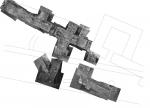Summary (English)
AGATHOPOLIS (Andrei Aladzhov – alajov@gmail.com) A sector of the northern fortification wall, 32 m long, was discovered. The fortification wall was 1.85 m wide, built in opus еmplectum at the end of the 4th – 5th century AD. Subsequently the wall was reconstructed at least twice. The Mediaeval parts of the wall were built of well-cut and uneven stones bonded with mud. The northeastern corner tower of the fortress was 5.95 m long with preserved width of 4.50 m and walls 1.80 – 1.95 m wide. A second rectangular tower 4 m in width, with walls 1.90 m wide, was discovered at 15 m to the west of the corner tower. At 3 m to the west of it another identical tower was discovered. Both towers flanked the passage of the northern fortification gate, 2 m wide and 6 m long. The gate was 3 m wide and was built at the end of the 4th – beginning of the 5th century AD. The gate was narrowed with 50 cm from each side at the end of the 5th – beginning of the 6th century AD. Two inner towers symmetrical to the outer ones were built at the inner side of the fortification wall after the beginning of the 10th century. Thus, the passage of the gate became twice longer than the original one. Two dolia in situ and sherds from several more dolia and amphorae were discovered in the eastern inner tower which indicated that it was used as a warehouse. Four strata were documented: Roman, Late Antique (4th – 6th centuries AD), Early Ottoman (16th – 17th centuries) and Revival (18th – 19th centuries). A wall of a house was discovered under the floor of the fortification gate. The finds included four terracotta lamps of the end of the 4th century AD and sherds from amphorae of the middle of the 4th century AD. The building was burned at the end of the 4th century AD and it was terminus post quem for the construction of the fortification wall. The finds from the excavations included sherds of Thracian pottery of 5th – 1st centuries BC, Hellenistic black-gloss pottery, Megarian bowls, Roman red-gloss pottery, Late Antique pottery including a sherd of a Gothic pottery, Early Mediaeval pottery, Byzantine pottery of the 10th – 14th centuries, Early Ottoman pottery of the 15th – 17th centuries, coins, mostly of the 4th – beginning of the 7th centuries AD, the earliest one of Licinius II minted in AD 320 and the latest one of Sultan Abdulmejid I minted in 1841, while there were no coins of the 12th and the 16th century found on the site.
- Andrei Aladzhov - Archaeological Institute with Museum
Director
Team
Research Body
- Archaeological Institute with Museum






![Download [PDF]](/excavation/skins/fasti/images/results/download_sml.png)

